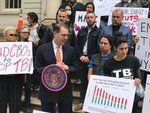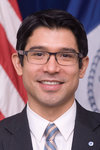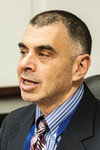A few of our stories and columns are now in front of the paywall. We at The Chief-Leader remain committed to independent reporting on labor and civil service. It's been our mission since 1897. You can have a hand in ensuring that our reporting remains relevant in the decades to come. Consider supporting The Chief, which you can do for as little as $3.20 a month.




City Council Members, immigrant-rights groups and public-health non-profits are warning the de Blasio administration that in the wake of a 10-percent spike in tuberculosis cases, additional money is needed to subsidize testing.
The TB increase in 2017 was the first significant uptick for the city in 25 years, according to the city’s Department of Health and Mental Hygiene. TB is contagious, potentially deadly, but very treatable once identified. It is most common among non-US born populations.
Areas With Most Cases
Eighty-six percent of the city’s tuberculosis patients were born outside the United States, according to data provided by the Health Department. The areas with the highest prevalence of it are Sunset Park, Brooklyn, western Queens, and Flushing. The leading countries of origin were China, the United States, the Dominican Republic, Ecuador, India, and Mexico.
In 2017, 613 cases were reported, compared to 556 the year before. At the same time, the Department of Health reported a rise in the incidence of multi-drug-resistant TB that is not cured by two of the most important antibiotics, and as a consequence is harder and more expensive to treat.
Council Member Mark Levine, chair of the Health Committee, and Council Member Carlos Menchaca, who heads the Immigration Committee, held a rally on the steps of City Hall May 14 to turn up the heat on the Mayor before the July 1 budget deadline. At stake is an additional $6.7 million, according to the Council Members.
“In the context of the overall city budget, now proposed to be $89 billion—billion with a b—this is less than one tenth of one percent of the total budget to address a looming public-health crisis,” said Mr. Levine. “We think it is a good investment.”
Complicating Factor
Mr. Menchaca told the crowd that 11 years of Federal and state budget cuts to TB-detection programs had left the city with little choice but to step up its commitment. Further complicating the city’s response, he said, was concern that because of the anti-immigrant tone set by President Trump, the immigrant or foreign-born persons would avoid the agencies that do the TB health screening for fear of being deported.
“What today really represents is a lack and a gap, a real gap, over the last 11 years that has exacerbated the issue around tuberculosis in our neighborhoods, and now we have to say ‘basta’—enough,” Mr. Menchaca said. “Right now we are living in a time when there is so much fear. We tried so hard this weekend to bring families down here, and people are afraid to even come out and ask for resources for their own families, so that’s what we are here to do.”
“TB disproportionately affects black New Yorkers,” said Amanda Lugg of the Harlem-based African Services Committee. “The impact of funding cuts to groups like African Services that try to find, prevent and treat TB is glaringly clear.”
She continued, “In a regular month, African Services tests over 300 people with free HIV tests. But we are only testing 10 people for TB because they cost money and we have to cover the cost of the test.”
‘Finding TB Too Late’
She continued, “As a result, we are finding TB too late and it is spreading. TB is preventable. TB is curable. It is 2018. This is New York City. This is unacceptable. We need our leaders to commit the political will and the funding to once and for all end TB in New York City."
The initial TB test costs $30.
For decades the city’s efforts in reducing the incidence of tuberculosis were part of a national public-health success story. According to the city’s Bureau of Tuberculosis Control, from 1992 through 2016 the city had an 85-percent decline in TB. But over the last 10 years, the rate of annual decline slowed significantly and then plateaued.
“In the epidemic in the '90s, the estimated cost to New York City was in the billions...because of hospital services, lost work, and all the strain on first-responders and other people on the front lines in treating this epidemic,” said Mr. Levine. “So it is simply foolish to forgo investing now, and it is an investment, in relatively modest expenses, like staffing clinics and subsidizing tests.”
‘Should All Be Scared’
He continued, “It is terrifying when we have multi-drug-resistant strains of TB and we see a rise in those cases and that then accelerates the risk of infection to the broader population. We should all be scared by that possibility, and acting early could prevent it from getting out of control.”
In a statement, the Department of Health said the de Blasio administration had set aside sufficient funds to deal with the spike in TB cases. “We have invested $14.7 million annually to combat tuberculosis, and are committing an additional $1.4 million this year to address the recent 10-percent increase in cases. These additional resources will be used to build capacity for critical services identifying and treating newly infected New Yorkers, monitoring patients currently on treatment and investigating all reported TB cases," it said.
“Tuberculosis is a deadly, yet curable disease. The Health Department is the leading provider of tuberculosis care in New York City, and we are concerned about these new data that show TB rates have increased among New Yorkers,” Health Commissioner Dr. Mary T. Bassett said in an earlier statement. “We’re committed to ensuring equitable access to rapid and quality diagnosis and treatment for all New Yorkers.”
’65% Cut by Feds’
“While the current city administration has maintained funding for TB-control efforts, over the last decade, New York City’s TB budget has been halved, including a staggering 65-percent reduction in Federal funds,” according to the Department of Health. “These funding cuts have resulted in reduced clinical services, decreased public-health activities, and significantly reduced staffing.”
“In densely populated cities with large numbers of international travelers, tuberculosis is an ongoing concern, made worse by evolving drug resistance,” said Dr. Mitchell Katz, President and Chief Executive Officer of NYC Health + Hospitals. “Identifying the disease and starting treatment early are critically important, especially in medically underserved communities, where the potential for rapid spread is greatest.”
The symptoms of an active TB infection include weight loss, a persistent cough lasting longer than three weeks, chest pain, coughing up blood or phlegm, loss of appetite, chills, fever, and night sweats.
Whenever a person who is sick with an active TB infection coughs, sneezes, speaks, sings, or engages in other activities that expose others to respiratory secretions, it puts TB germs in the air.
How It Isn’t Spread
Health officials say TB is not spread by shaking hands, sharing food, or through sexual activity. “Most people do not know they have TB until they become sick,” according to the Department of Health. “That is why it is critical for people at high risk for TB to get tested. People who are at risk include individuals who have traveled to or lived in a country with high rates of TB or who have spent a long time around someone with active TB disease.”
The increase of the incidence of TB is on the radar of the city’s Emergency Medical Service unions, which warn that officials need to be proactive in response.
“While our members are trained to be aware, EMS personnel are in the front lines of this deadly airborne disease, which puts our members at higher risks to exposures of contracting TB than the average person,” said Oren Barzilay, president of EMS Local 2507 of DC 37.
“An airborne infectious disease increases the risks we face because it’s harder to control as opposed to a blood-borne infection,” said Vincent Variale, president of EMS Officers Local 3621 of DC 37.
We depend on the support of readers like you to help keep our publication strong and independent. Join us.
Comments
No comments on this item Please log in to comment by clicking here